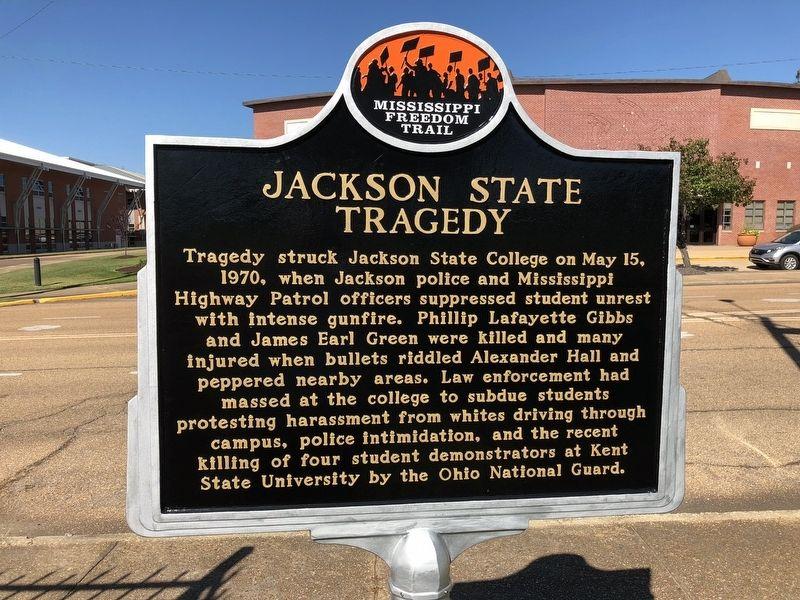Gibbs-Green Virtual Reality Experience Unveiled at JSU
June 26, 2023

Jackson State University's Center for Innovation and Entrepreneurship, in collaboration with the Margaret Walker Center, unveiled a new virtual reality experience at its 53rd Gibbs-Green Commemoration in Ayer Hall in June.
Through fully-immersive VR goggles, attendees can examine the devastating events culminating in lethal violence on May 15, 1970, on the Jackson State campus. Viewers can watch the events unfold through the eyes of a student housed in Alexander Hall.
"It gives you a sense of what happened, but also allows you to engage with history and hold that history in your hands at the same time," said Robert Luckett, Ph.D., director of the Margaret Walker Center.
According to Luckett, viewers can also interact with old newspaper clippings and news broadcasts that covered, often inaccurately, the events surrounding the tragedy.
"You're able to pick up and read documents on a table that include news clippings showing the way the press was trying to craft the story as what was known then as the Jackson State riots. For a long time, the press characterized the students who were massacred and attacked that night as criminals. They criminalized the victims as a way to justify the law enforcement's actions," said Luckett, who mentions documents from U.S. President Richard Nixon, who suggested that the students were indeed responsible and not victims.
With approximately four years of development, spanning pre-pandemic, the project is intended to memorialize the victims and survivors of the Gibbs-Green shooting while also creating a "thoughtful VR experience that was deeply moving, engaging and accessible, particularly to young people." Four virtual reality goggles were donated to the MWC by the Center for Innovation.
Almesha L. Campbell, Ph.D., assistant vice president for the Division of Research and Economic Development and head of the Gibbs-Green VR project, says that Jackson State is developing a variety of interdisciplinary VR content as a way to reach younger audiences and promote a stimulating learning environment.
"We have to meet the students where they are but help preserve history," said Campbell, adding that every JSU student should carry on the legacy of the Gibbs-Green tragedy. "Eventually, we want to make sure that this gets into different museums. We are also going to turn this into a research study to understand how viewing the experience impacts those who lived through the tragedy versus those who did not, as well as study how viewing via VR, versus other means, impacts people," she shared.
Campbell explained that all of the information detailing the incident initially came from the Mississippi Department of Archives.
"But we must remember that the story was told from another perspective during that time. So, it was important that we also captured the perspectives of the people who lived through it," she added.
Luckett and Campbell emphasize the many hands that brought the project to life. The short film includes voiceovers from current and past students of JSU, as well as a scene and voiceover from Peoples.
JSU alumnus and survivor of the shooting, James "Lap" Baker also participated in the project. Baker recalls being a sophomore geography major at the time. He says he stood on the same side of the street where Green was shot while cutting through the campus on his way home from work.
"You have to remember and always know where you came from. That's your past. To have an understanding of where you are. That's your present. Then, to have a vision of where you should be going. That's your future," said Baker. "I'm glad the VR is available because it keeps what happened 53 years ago alive. Now it needs to be more nationally shown and exposed so that people know what really happened here at Jackson State."
The content expressed through the virtual reality environment may be upsetting and triggering to viewers due to depictions of police violence and gunshot noises. Parental guidance is advised as the experience may not be suitable for young children.
The virtual reality experience was conceptualized by Campbell, with support from the Division of University Communications, including Tangelia Kelly, Ph.D, director of marketing, and Kentrice Rush, digital media manager, and L.A. Warren, director of research communications in the Division of Research and Economic Development. Funding support was provided by HP, EDUCAUSE, and the Bill and Melinda Gates Foundation. The experience was built by Lobaki, Incorporated.

The Gibbs-Green Commemoration is a reminder of the night Jackson City Police and Mississippi Highway Patrolmen marched on the then Jackson State College campus "under the pretense of disrupting a student protest" and fired nearly 500 rounds of ammunition and buckshot in 28 seconds into Alexander Hall, which was a women's dormitory.
Two were killed: Phillip Lafayette Gibbs, a junior political science major, and James Earl Green, a senior at nearby Jim Hill High School. Dozens were injured by flying debris. No police officer was ever held accountable. Shortly after the shootings, then President John A. Peoples, Ph.D., decided to close the campus and cancel the Class of 1970 graduation ceremonies.
As an alumna of the university and member of the Class of 1973, JSU's Acting President, Elayne Hayes-Anthony, Ph.D., paid homage to the victims and survivors for their "bravery and resilience.”
"I want to thank each and every one of you for gathering here today, and to those that were there that night, to collectively pay homage to a part of JSU's legacy that continues to resonate in our hearts and minds," said Hayes-Anthony. "While we mourn their lives, we also celebrate who they were and what they represent in the history of this country as involuntary martyrs. Let their lives remind us of where we have been, how far we have come, and how much further we have yet to go as a human race."